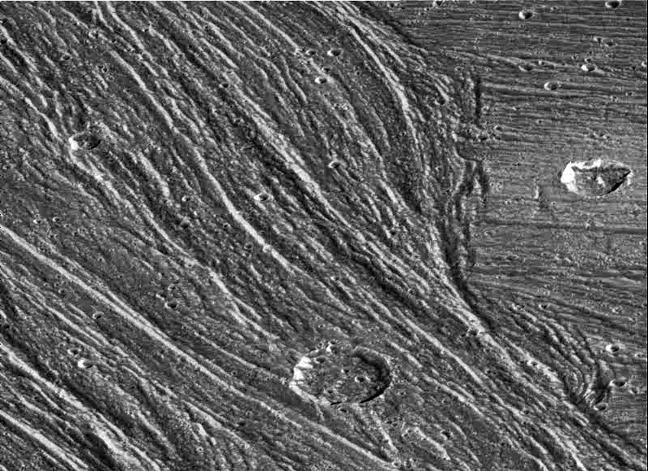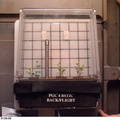
WIKIARCHIVES.SPACE
The Human Spaceflight Archive

Complex sets of ridges and grooves are visible in this image of the Nippur Sulcus region on Jupiter's largest moon Ganymede. NASA's Galileo spacecraft imaged this region as it passed Ganymede during its second orbit through the Jovian system. The Nippur Sulcus region is an example of Bright Terrain on Ganymede which is typified by multiple sets of ridges and grooves. The intersections of these sets reveal complex age relationships. North is to the top of the picture and the sun illuminates the surface from the southeast (lower right). In this image a younger sinuous northwest-southeast trending groove set cuts through and apparently destroys the older east-west trending features on the right of the image, allowing scientists to determine the sequence of events that led to the region's formation. The area contains many impact craters. The large crater in the bottom of the image is about 12 kilometers (8 miles) in diameter.
Information
- Taken in
- Author
- NASA/JPL/Brown University
- Description
-
Complex sets of ridges and grooves are visible in this image of the Nippur Sulcus region on Jupiter's largest moon Ganymede. NASA's Galileo spacecraft imaged this region as it passed Ganymede during its second orbit through the Jovian system. The Nippur Sulcus region is an example of Bright Terrain on Ganymede which is typified by multiple sets of ridges and grooves. The intersections of these sets reveal complex age relationships. North is to the top of the picture and the sun illuminates the surface from the southeast (lower right). In this image a younger sinuous northwest-southeast trending groove set cuts through and apparently destroys the older east-west trending features on the right of the image, allowing scientists to determine the sequence of events that led to the region's formation. The area contains many impact craters. The large crater in the bottom of the image is about 12 kilometers (8 miles) in diameter.
The image, centered at 51 degrees latitude and 204 degrees longitude, covers an area approximately 79 kilometers (50 miles) by 57 kilometers (36 miles) across. The resolution is 93 meters (330 feet) per picture element. The images were taken on September 6, 1996 at a range of 9,971 kilometers (6,232 miles) by the solid state imaging (CCD) system on NASA's Galileo spacecraft.
The Jet Propulsion Laboratory, Pasadena, CA manages the Galileo mission for NASA's Office of Space Science, Washington, DC. JPL is an operating division of California Institute of Technology (Caltech).
- Created on
- Thursday 20 November 1997
- Albums
- US SPACE PROGRAM / PROBES / JUPITER / GALILEO / Mission Photos (Edited) / JUPITER / GANYMEDE
- Source link
- https://photojournal.jpl.nasa.gov
- Visits
- 15
- Rating score
- no rate
- Rate this photo
- License
- Public Domain
- Modified by WikiArchives
- No (original)
- Downloads
- 1
Powered by Piwigo




